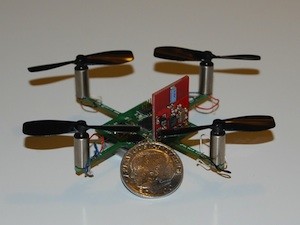Hackable DIY Quadrotor Kit
February 05, 2013
on
on

Three Swedish electronic engineers started out with a simple idea. To make a printed circuit board fly.
The first iteration of the nano quadcopter was a PCB with rotors glued on top and the 2.4GHz radio sticking out. Although they got it to fly, the device was so fragile that each crash could be its last.
Now, after more than three years of development the Swedes have produced a crash resistant Quadrotor dubbed Crazyflie. The name the result of a spelling error which, in hindsight, worked out pretty well as it ensures the coveted top rank in Google.
Marcus Eliasson, Arnaud Taffanel, and Tobias Antonsson worked on the Crazyflie as a side project next to their day jobs. To finance the project they incorporated as Bitcraze in 2011.

The Crazyflie comes as a kit and is built for hacking. To keep the project completely open the Bitcraze team pledged only use open source development tools even if they had access to proprietary alternatives that suited the job better. They’ve compiled a wiki of all the tools for developing mechanics, hardware, firmware and client software. Design information and source codes can be found via the Bitcraze website.
The quadcopter is 9 cm rotor to rotor, weighs 19 grams and can carry a payload of up to 10 grams. It can stay in the air for 7 minutes with the standard battery. The basic kit comes with a gyroscope and accelerometer and for an extra $24 you'll get a magnetometer and altimeter as well. Though there is no firmware for the extra sensors yet, so you'll have to get creative.
You can preorder the Crazyflie until February 18 at Seeedstudio. The basic kit is $149.
Here’s the video of the Craziefly in action. Be sure to check out the hacks at the 2.14 time code. Very nice. Training wheels, mounted camera, computer vision and more.
Image: Bitcraze: The Crazyflie in the picture is modified with a keychain camera add-on.
The first iteration of the nano quadcopter was a PCB with rotors glued on top and the 2.4GHz radio sticking out. Although they got it to fly, the device was so fragile that each crash could be its last.
Now, after more than three years of development the Swedes have produced a crash resistant Quadrotor dubbed Crazyflie. The name the result of a spelling error which, in hindsight, worked out pretty well as it ensures the coveted top rank in Google.
Marcus Eliasson, Arnaud Taffanel, and Tobias Antonsson worked on the Crazyflie as a side project next to their day jobs. To finance the project they incorporated as Bitcraze in 2011.

The Crazyflie comes as a kit and is built for hacking. To keep the project completely open the Bitcraze team pledged only use open source development tools even if they had access to proprietary alternatives that suited the job better. They’ve compiled a wiki of all the tools for developing mechanics, hardware, firmware and client software. Design information and source codes can be found via the Bitcraze website.
The quadcopter is 9 cm rotor to rotor, weighs 19 grams and can carry a payload of up to 10 grams. It can stay in the air for 7 minutes with the standard battery. The basic kit comes with a gyroscope and accelerometer and for an extra $24 you'll get a magnetometer and altimeter as well. Though there is no firmware for the extra sensors yet, so you'll have to get creative.
You can preorder the Crazyflie until February 18 at Seeedstudio. The basic kit is $149.
Here’s the video of the Craziefly in action. Be sure to check out the hacks at the 2.14 time code. Very nice. Training wheels, mounted camera, computer vision and more.
Image: Bitcraze: The Crazyflie in the picture is modified with a keychain camera add-on.
Read full article
Hide full article


Discussion (0 comments)